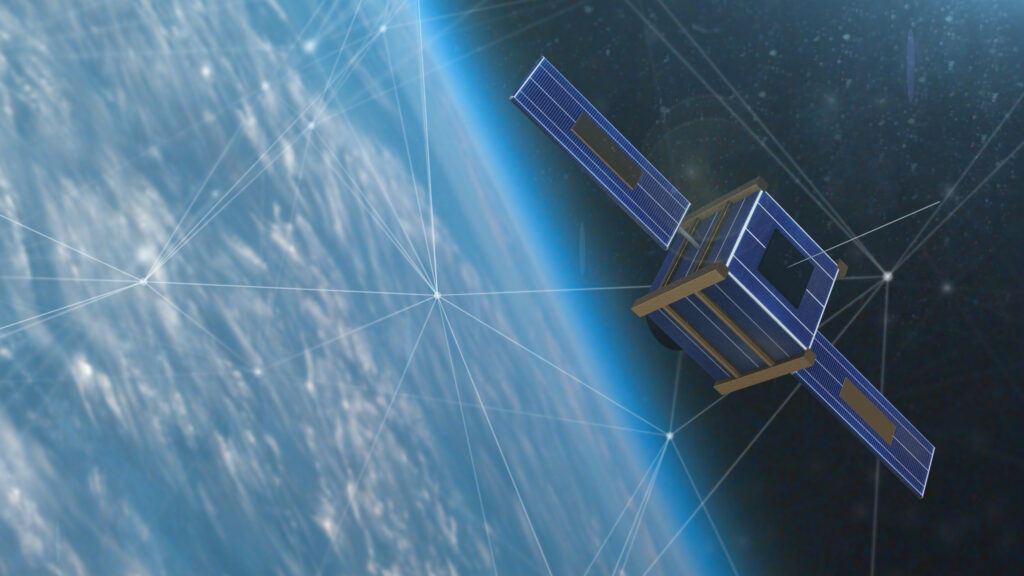
A Dutch hub for processing data in new space
In the ‘New Space’ age, satellite technology is no longer the exclusive domain of the really big players such as NASA and ESA. Cubesats and other smallsats now offer commercially viable options to a wide range of interested parties. Dutch optical sensors have always played a prominent part in conventional space technology. A new control and data processing unit for optical instruments on smaller satellites strengthens this position in new space even more.
The development and subsequent launch of a new satellite used to be a megaproject taking many years of development time and requiring an astronomical budget. Only very large organizations with national or international support could even begin to think of crossing the boundary into space. The considerable size and weight of satellites were important factors, both for development costs and launch efforts.
Today, many satellites are of the much smaller smallsat category (up to 1,000 kg). For instance, a standard cubesat unit measures just 10 cubic centimeters and has the same content as a one-liter milk carton. A complete cubesat can consist of 1-24 such units. The development usually takes an Agile approach and is many times quicker than that of traditional satellites. Furthermore, thanks to the much smaller weight and size, the launching costs are much lower. Cubesats have been a huge success over the last decade, and the number of active satellites has gone up from fewer than 1,000 in 2011 to more than 5,000 today.
Cubesats have obvious limitations when it comes to onboard technology. They can only carry very small instruments and usually have no room for thrusters, which limits their lifespan considerably. Since every satellite is in free fall, thrusterless cubesats will slowly fall back down to Earth and burn up once they enter the atmosphere.
For these reasons, the first wave of cubesats is now being followed by a shift toward slightly larger devices, such as microsats (10-100 kg) and minisats (100-1,000 kg). These satellites can carry larger instruments and have onboard thrusters for course correction, which allows them to maintain their orbital position for a much longer period. While cubesats are expected to last about a year, a microsat could be operational for approximately five to ten years.
Logical bridge
Many of the measurement and observation instruments on satellites are optical in nature. Cameras and lenses register and record light in many wavelengths, from infrared to ultraviolet and beyond. The possible use cases are virtually unlimited: from geological mapping, meteorological surveys and atmospheric particle measurements to registering oil spills at sea, volcanic eruptions or forest fires. The optical industry in the Netherlands has traditionally been an important producer of high-grade optical instruments for European and global satellite projects. The Dutch government considers this hard-earned position well worth fighting for, and it has made funds available for further innovation.
One of these funded projects to support the Dutch optical industry is the development of a control and data processing unit (CDPU) by Technolution Advance and the Royal NLR – Netherlands Aerospace Centre. The CDPU is mainly targeted toward microsats. It’s a hub that forms a logical bridge between the optical instruments and the satellite platform. It will offer standardized hardware interfaces for integrating the instruments, as well as sophisticated facilities for processing the optical data.
The hardware of the CDPU needs to be robust enough to guarantee operational performance according to the specifications for the whole of the projected in-orbit lifetime of the smallsat.
Therefore, while Technolution Advance and NLR will employ Agile methods for quick development, they’ll also use the best practices of the ‘conventional’ space industry to ensure maximum reliability and durability of the system. The base design of the CDPU still allows for flexibility in the area of radiation tolerance, which means that the reliability level can always be tuned to the mission of the satellite. For missions with a shorter projected lifespan, for instance, commercial off-the-shelf equipment with a lower radiation tolerance could be used.
The CDPU will work closely with the optical instruments on the satellite and allow manufacturers to concentrate fully on the core tasks of their instruments. In this way, the processing unit brings about a considerable improvement of the ‘upstream’ capabilities of the Dutch optical industry – the usability and quality of the equipment sent up into space.
The CDPU’s built-in data processing facilities will allow satellite instruments to pre-process optical data before sending them back down to Earth, thus freeing up a lot of bandwidth. For example, when the images of an optical instrument don’t show the surface due to cloud formations, the CDPU can filter out those images before sending useful data down. Because the processing power will be partly provided by FPGAs, the embedded data processing algorithms will be customizable and reconfigurable, allowing for optimization of the data streams for every particular end goal.
Constellation space
While larger smallsats offer more functionality and practical applications, their modest size still means they remain limited to a relatively small number of tasks. But this limitation can be overcome when several of them can be made to work together as a single system. Smallsats with different types of instruments can be connected to communicate with one another and coordinate their movements and activities. This so-called “constellation space” can perform a great number of different observation tasks, the data of which can be made commercially available.
Constellation spaces can even signal the start of something like “constellation as a service” (CaaS), a subscription-based service that allows paying customers to operate the constellation space with specific monitoring functions and to download specific data. For CaaS to work, a tight security system needs to be put in place in the satellites, to prevent unlicensed parties from downloading the data at will. This is a marked difference from current satellites, which tend to send their data downstream with minimal encryption protection, or even without any encryption at all. Of course, upstream communication needs protection as well to prevent unwanted take-over of the constellation space controls.
Collaboration
In the CDPU project, Technolution Advance and NLR work closely together with optical-instrument builders and smallsat platform integrators. Both development partners greatly value collaboration and co-creation, which allows everyone to add their specific skills and knowledge to the ecosystem. Instrument builders and smallsat platform integrators can concentrate their efforts on demonstrating and validating the CDPU concept, while Technolution Advance and NLR can focus on specifying, developing, building and testing reliable, modular electronics that will greatly support the Dutch new space activities.

Dutch funding of innovative technology
The Dutch technology sector has done amazingly well during the pandemic, partly due to generous funding by the Dutch government. Even before the pandemic, a program called Small Business Innovation Research (SBIR) was in place, which allowed a lot of smaller businesses to initiate technological innovations. The CDPU by Technolution Advance and NLR is an SBIR-funded program commissioned by the Netherlands Space Office (NSO).
A more recent program, Nxtgen Hightech, will invest 1.2 billion euros over a period of seven years in six different application areas, such as clean energy, faster processors and agricultural robots. Under this program, utilizing our experience with embedded control electronics for data acquisition, Technolution Advance will participate in collaboration-based ecosystems to develop metrology systems for semiconductors, life sciences and photonic integrated circuits.
These funding programs strongly support the typical Dutch way of consensus-based collaboration and decision-making. Many large, innovative projects bring together partners from different disciplines, often leading to new, successful consortiums or even creating new regional technology hubs, such as the conglomerate of tech companies clustered around ASML.
